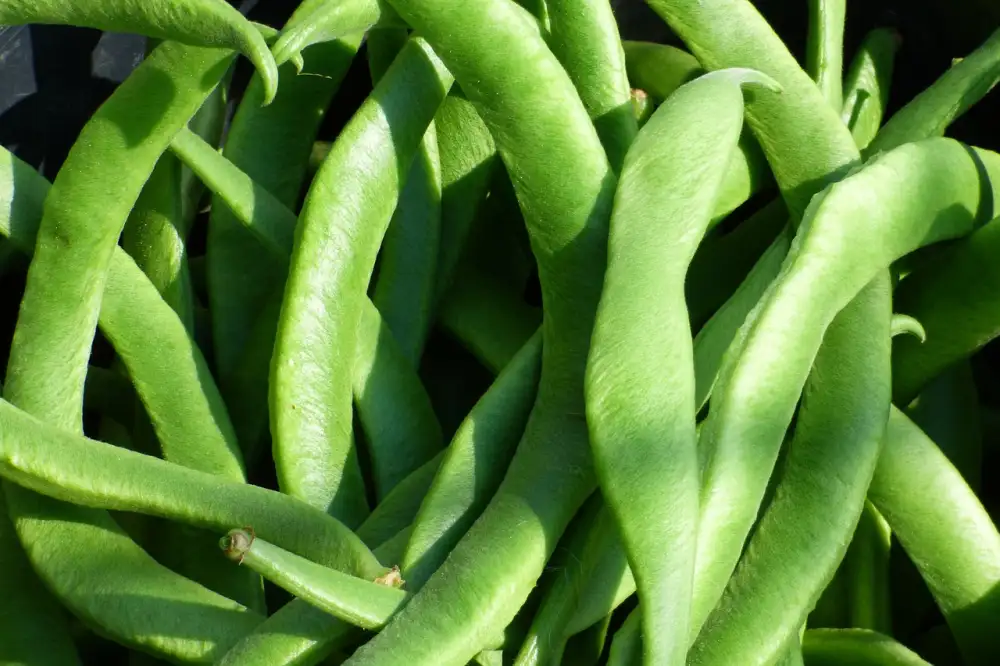Homegrown Delights: Unleash the Flavorful Potential of Runner Beans

Runner beans, scientifically known as Phaseolus coccineus, are a versatile and nutritious vegetable that have been cultivated for centuries. Native to Central America, these vibrant green pods are a staple in many cuisines around the world. With their unique flavor and numerous health benefits, runner beans are a delightful addition to any meal. Whether you're a seasoned chef or an amateur cook, exploring the culinary wonders of runner beans will surely elevate your dishes to new heights.
Nutritional benefits of runner beans
Runner beans are not only delicious but also packed with essential nutrients. They are an excellent source of dietary fiber, which aids in digestion and promotes a healthy gut. These beans are also rich in vitamins such as vitamin C, vitamin K, and folate, which are vital for maintaining a strong immune system and supporting cell growth. Additionally, runner beans contain minerals like iron, magnesium, and potassium that contribute to overall well-being. Incorporating runner beans into your diet can help lower cholesterol levels and regulate blood sugar levels due to their low glycemic index. With their high nutrient content, runner beans are a fantastic addition to any balanced diet.
Culinary uses of runner beans
Culinary Uses of Runner Beans:
Runner beans are incredibly versatile in the kitchen, offering a wide range of culinary possibilities. They can be enjoyed both raw and cooked, adding a delightful crunch and vibrant flavor to any dish.
One popular way to prepare runner beans is by steaming or boiling them until tender-crisp. This method helps retain their bright green color and preserves their nutritional value. These tender beans can be used as a side dish, tossed into salads, or incorporated into stir-fries for added texture and taste.
Runner beans also shine when sautéed with garlic and olive oil. This simple yet delicious preparation brings out their natural sweetness while maintaining their crispiness. Sautéed runner beans make a fantastic addition to pasta dishes, rice bowls, or even served on top of grilled meats.
For those looking to explore more creative uses of runner beans, they can be pickled or fermented to create tangy and flavorful condiments. Pickled runner beans add a zesty kick to sandwiches, burgers, and charcuterie boards. Fermented runner beans develop a unique umami flavor that pairs well with Asian-inspired dishes like sushi rolls or noodle bowls.
In addition to these cooking methods, runner bean pods can also be used as edible containers for stuffing. Simply blanch the pods briefly in boiling water before filling them with your favorite ingredients such as cheese, herbs, or minced meat. Baked until tender, stuffed runner bean pods offer an innovative twist on traditional stuffed vegetables.
With their versatility in the kitchen, it's no wonder that runner beans have become a staple ingredient in many cuisines around the world. From simple preparations to more adventurous uses, these delicious legumes are sure to elevate any dish they are added to. So go ahead and unleash your creativity by incorporating runner beans into your next culinary masterpiece!
Growing and harvesting runner beans
Growing and harvesting runner beans is a rewarding experience that allows you to enjoy the freshest, most flavorful beans right from your own garden. Runner beans are relatively easy to grow and thrive in temperate climates. They prefer well-drained soil with plenty of organic matter and full sun exposure.
To start, sow the seeds directly into the ground or in pots after the last frost has passed. Plant them about 2 inches deep and 6 inches apart, providing support such as trellises or poles for the plants to climb on. Keep the soil moist but not waterlogged, as runner beans require regular watering.
As the plants grow, be sure to regularly check for pests like aphids or slugs and take appropriate measures to control them. Additionally, keep an eye out for any signs of diseases such as powdery mildew or rust and address them promptly.
Harvesting runner beans is a delightful task that should be done when the pods are young and tender, usually around 6-8 inches long. Simply snap off the pods from the plant using your fingers or a pair of scissors. Be careful not to damage the plant while harvesting.
Remember that runner beans can continue producing throughout the season if you harvest regularly. The more you pick, the more they will produce! However, it's important not to let them become overripe on the vine as this can affect their taste and texture.
By following these simple steps, you can enjoy a bountiful harvest of delicious runner beans straight from your own garden. So roll up your sleeves, get your hands dirty, and revel in the joy of growing and harvesting these delightful legumes!
Popular runner bean recipes
Popular Runner Bean Recipes
Runner beans are not only nutritious but also incredibly versatile in the kitchen. Here are some popular recipes that showcase the delicious potential of these homegrown delights:
1. Runner Bean Salad: Toss blanched runner beans with cherry tomatoes, red onion, and feta cheese. Drizzle with a lemon vinaigrette for a refreshing summer salad.
2. Runner Bean Curry: Sauté onions, garlic, and spices like cumin and turmeric. Add chopped runner beans, coconut milk, and simmer until tender. Serve with rice or naan bread.
3. Runner Bean Stir-Fry: Heat oil in a wok and stir-fry sliced runner beans with bell peppers, carrots, and ginger. Season with soy sauce and sesame oil for a quick and healthy side dish.
4. Runner Bean Soup: Simmer chopped runner beans with vegetable broth, diced potatoes, onions, and herbs like thyme or rosemary. Blend until smooth for a comforting soup.
5. Runner Bean Casserole: Layer cooked runner beans with sautéed mushrooms, onions, and grated cheese in a baking dish. Top with breadcrumbs and bake until golden brown.
These recipes highlight the natural sweetness of runner beans while incorporating various flavors from different cuisines. Experimenting with these recipes will surely delight your taste buds!
Remember to adjust cooking times based on the tenderness of your runner beans to achieve the perfect texture in each dish.
Tips for storing and preserving runner beans
Tips for Storing and Preserving Runner Beans:
1. Refrigeration: To keep runner beans fresh, store them in a perforated plastic bag or an airtight container in the refrigerator. They can stay fresh for up to 5 days.
2. Blanching and Freezing: To preserve runner beans for longer periods, blanch them in boiling water for 2-3 minutes, then transfer them to an ice bath to stop the cooking process. Once cooled, drain and pack them into freezer-safe containers or bags. They can be stored in the freezer for up to 12 months.
3. Canning: Another way to preserve runner beans is by canning them. Clean and trim the beans, then pack them into sterilized jars with saltwater brine or vinegar solution. Process the jars using a pressure canner according to recommended guidelines.
4. Pickling: Runner beans can also be pickled for added flavor and extended shelf life. Prepare a pickling solution of vinegar, water, sugar, and spices like dill seeds or mustard seeds. Pack the cleaned beans into sterilized jars and pour the hot pickling solution over them. Seal the jars tightly and let them sit at room temperature for a few weeks before enjoying.
5. Drying: If you prefer dried runner beans, allow the pods to fully mature on the vine until they turn dry and brittle. Harvest the dried pods and remove the beans from inside. Store these dried beans in a cool, dark place in an airtight container.
By following these storage and preservation tips, you can enjoy the flavors of runner beans throughout the year while reducing waste and maximizing their nutritional value.
In conclusion, runner beans are a true culinary gem that should not be overlooked. Their vibrant color, crisp texture, and unique flavor make them a delightful addition to any dish. Not only are they delicious, but runner beans also offer numerous health benefits. Packed with vitamins, minerals, and fiber, they contribute to a well-balanced diet and promote overall wellness.
From soups and stews to salads and stir-fries, the culinary uses of runner beans are endless. They can be enjoyed both as a main ingredient or as a flavorful side dish. Their ability to absorb flavors makes them perfect for incorporating into various cuisines.
Growing and harvesting runner beans is relatively easy, making them an excellent choice for home gardeners. With proper care and attention, you can enjoy a bountiful harvest of fresh runner beans throughout the growing season.
To make the most of your runner bean harvest, try out popular recipes like runner bean curry or roasted garlic buttered runner beans. These dishes showcase the versatility of this humble vegetable and will surely impress your family and friends.
When it comes to storing and preserving runner beans, it's essential to handle them with care. Store them in a cool place or blanch and freeze them for longer shelf life. By following these tips, you can enjoy the delicious taste of runner beans even when they're out of season.
So why not embrace the versatility of runner beans? Whether you're a seasoned cook or just starting your culinary journey, these homegrown delights are sure to add flavor and excitement to your meals. So go ahead and explore the wonderful world of runner beans – your taste buds will thank you!
Published: 21. 02. 2024
Category: Home



